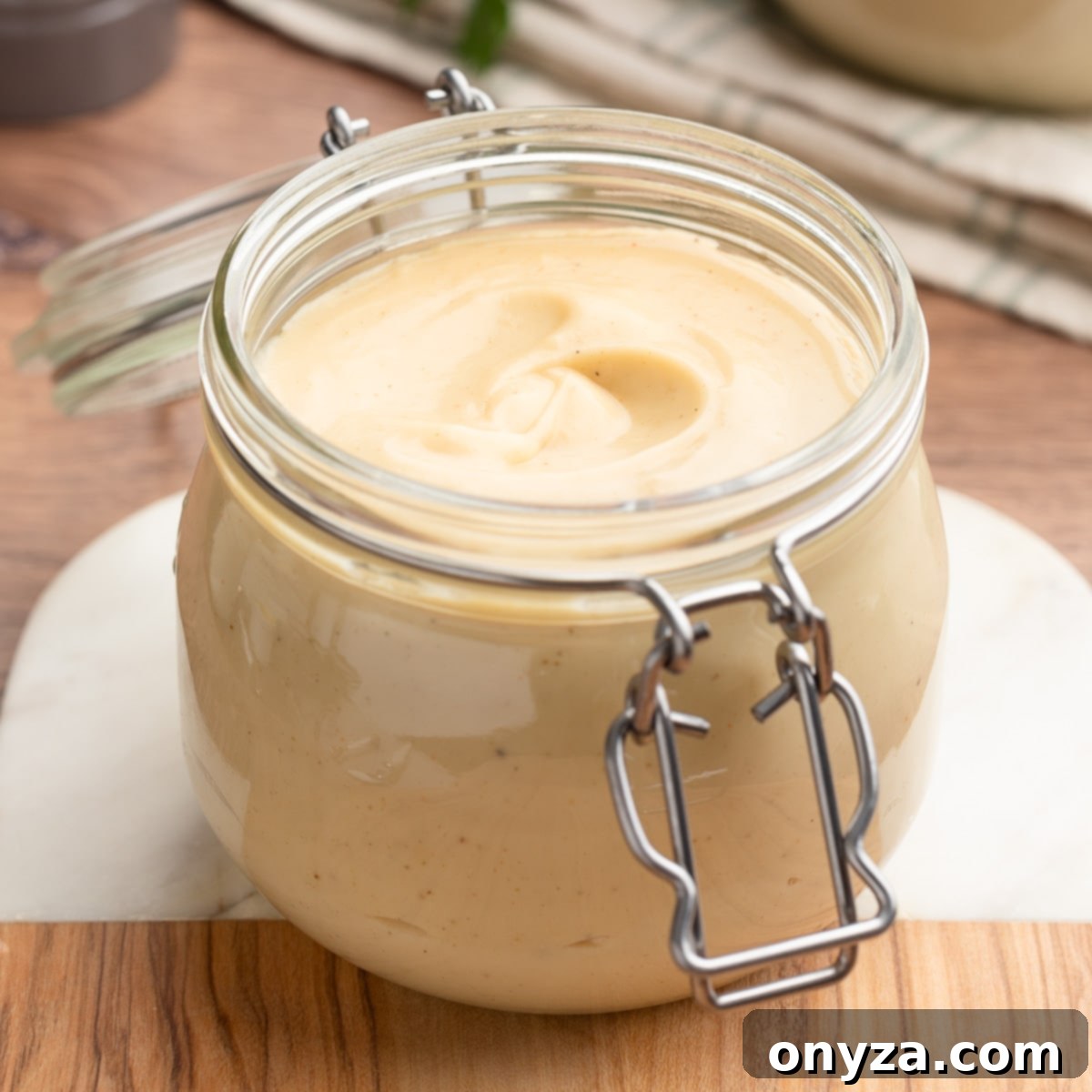Mastering Homemade Condensed Cream of Chicken Soup: A Versatile Kitchen Essential
Transform your everyday cooking with this incredibly easy and remarkably versatile recipe for Homemade Condensed Cream of Chicken Soup. Far superior to its canned counterparts, this kitchen staple serves as the perfect foundation for a myriad of dishes, infusing your favorite casseroles, soups, and gravies with a rich, authentic homemade flavor. Say goodbye to artificial ingredients and excessive sodium, and hello to a creamy, savory base that you control.
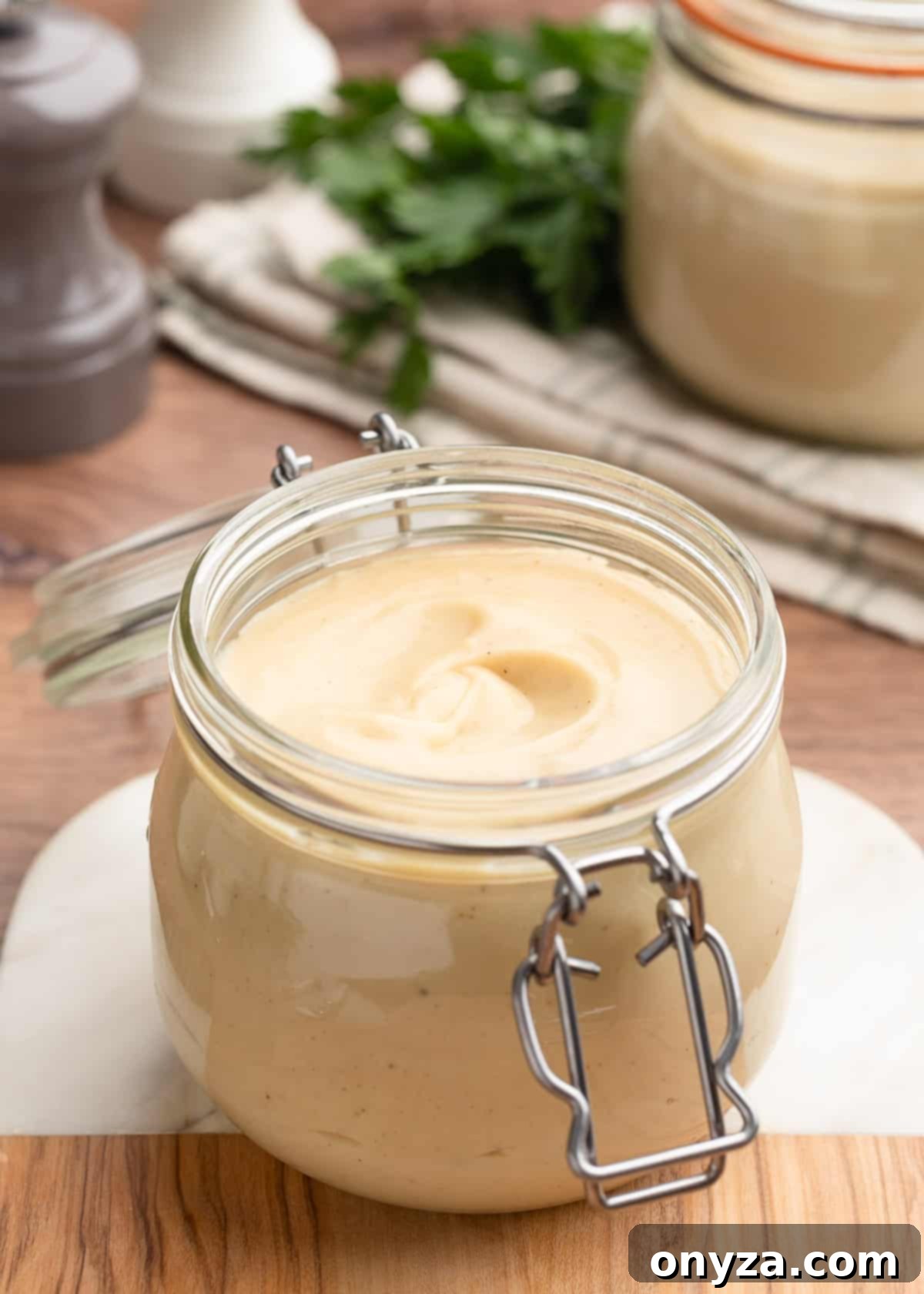
Why Choose Homemade Condensed Cream of Chicken Soup?
Embracing homemade versions of kitchen staples like condensed cream of chicken soup offers a multitude of benefits that elevate your cooking and promote healthier eating habits. This recipe is designed to be a direct 1:1 substitute for canned soup, yet it delivers a depth of flavor and quality you simply can’t achieve from a store-bought can.
- Unmatched Flavor and Texture: Experience the difference of real butter, fresh milk, and quality broth. This homemade version boasts a creamier texture and a more nuanced, savory chicken flavor that will make your comfort food recipes truly shine. Many families, including my own, find it significantly more appealing than the canned alternative.
- Sodium Control: One of the biggest advantages of making your own condensed soup is the ability to precisely control the sodium content. Store-bought condensed soups are often laden with sodium, which can overwhelm dishes and be a concern for health-conscious individuals. By using low-sodium broth, chicken base, and seasoning to your taste, you ensure your meals are both delicious and healthy.
- Wholesome Ingredients: Avoid the artificial preservatives, flavors, and emulsifiers often found in commercially produced soups. This recipe uses simple, wholesome ingredients you likely already have in your pantry, providing peace of mind about what you’re feeding your family.
- Economical and Convenient: While it requires a few minutes of active preparation, making a batch of this soup from scratch can be more cost-effective in the long run than repeatedly buying individual cans. This recipe yields slightly more than two 10.5-ounce cans of condensed soup, making it ideal for meal prepping. Store it in the refrigerator in convenient, ready-to-use portions, and you’ll always have a flavor booster at your fingertips.
Crafting Your Own: How to Make Homemade Condensed Cream of Chicken Soup
Making this condensed soup is a straightforward process, relying on fundamental cooking techniques to build rich flavors and a perfect consistency. Below is a detailed guide to walk you through each step. For precise measurements, please refer to the complete recipe card at the end of this article.
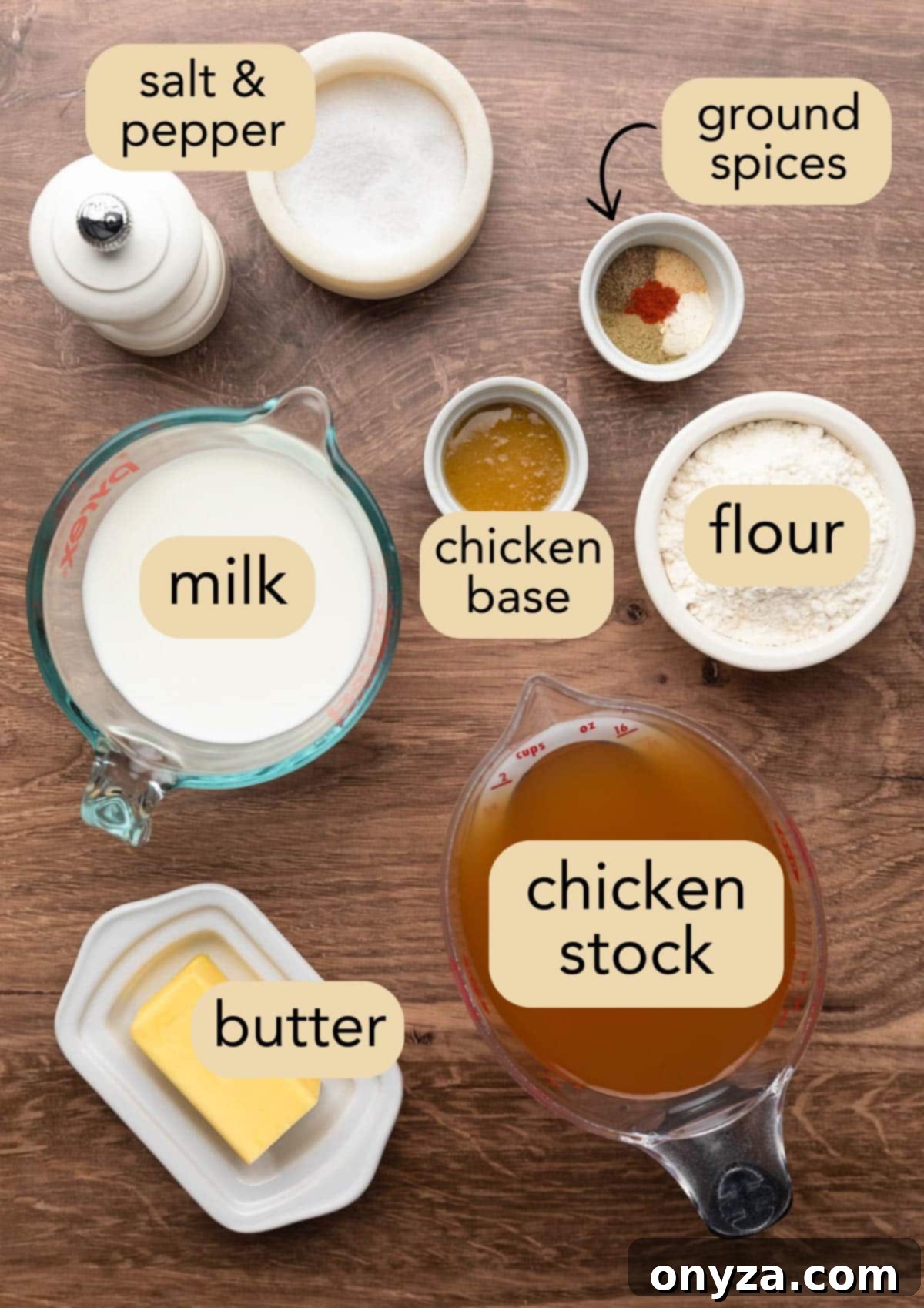
Step 1: Building the Roux – The Foundation of Creaminess
The first crucial step is creating a roux, which is a mixture of fat and flour that acts as a thickening agent for the soup. In this recipe, we use a slightly modified ratio compared to a classic roux, incorporating a bit more flour to achieve the extra-thick consistency characteristic of condensed soup.
Begin by melting 1/4 cup of unsalted butter in a medium pot (a 3-quart saucepan works well) over medium-high heat. The choice of butter can subtly influence the flavor and color of your soup; a high-quality butter like Kerrygold, with its rich flavor and golden hue, is a wonderful choice here.
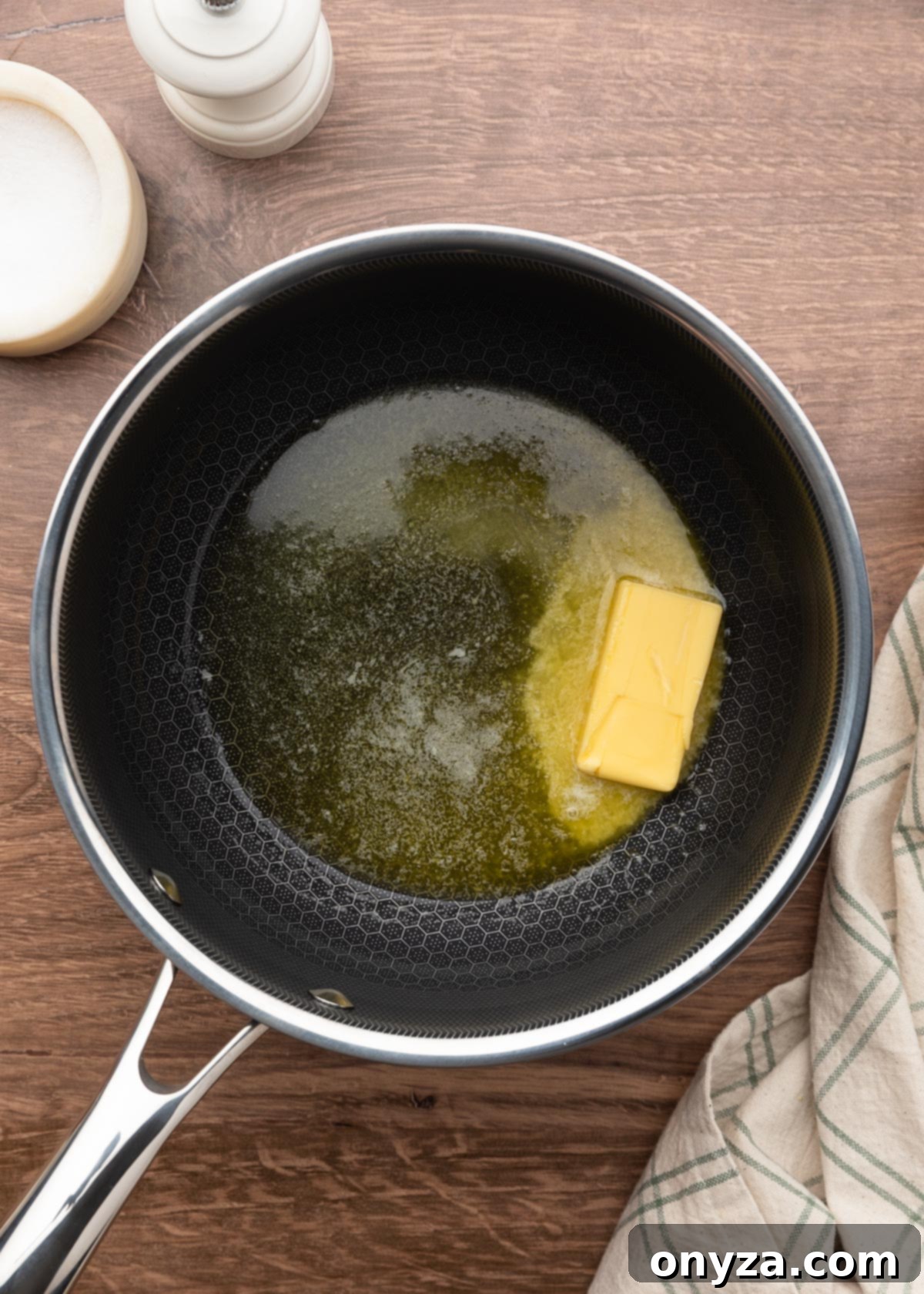

Once the butter is fully melted, reduce the heat to low. Add the all-purpose flour and whisk continuously to combine it with the melted butter. At first, the mixture will appear very thick and clumpy. This is perfectly normal. As it cooks gently over low heat, continue stirring or whisking for approximately 3 minutes. The goal is to cook out the raw flour taste without letting the roux brown. We want a “white roux” – pale in color – to maintain the light hue of cream of chicken soup. During this cooking time, you’ll notice the mixture gradually loosen, transforming into a more paste-like consistency.
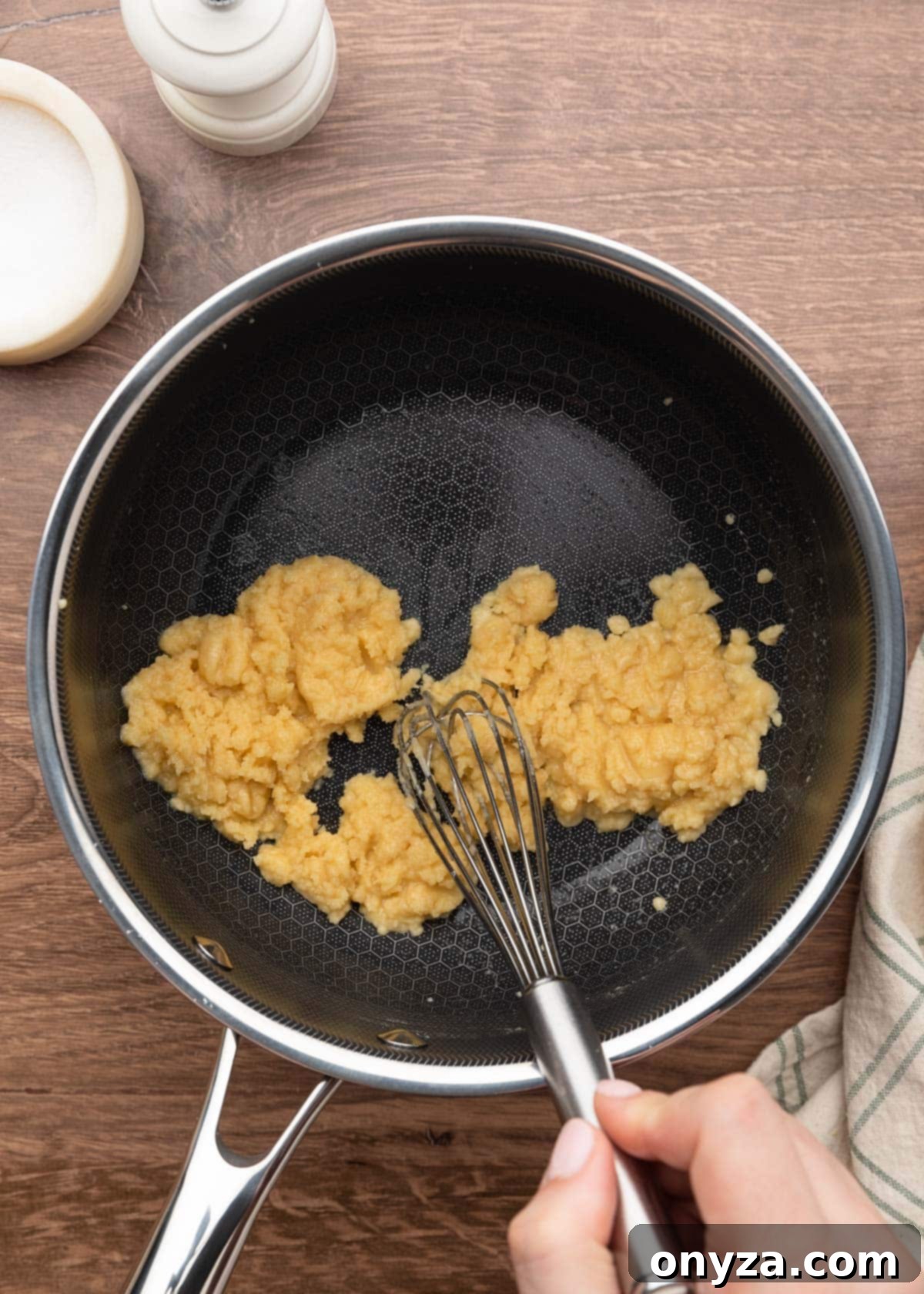
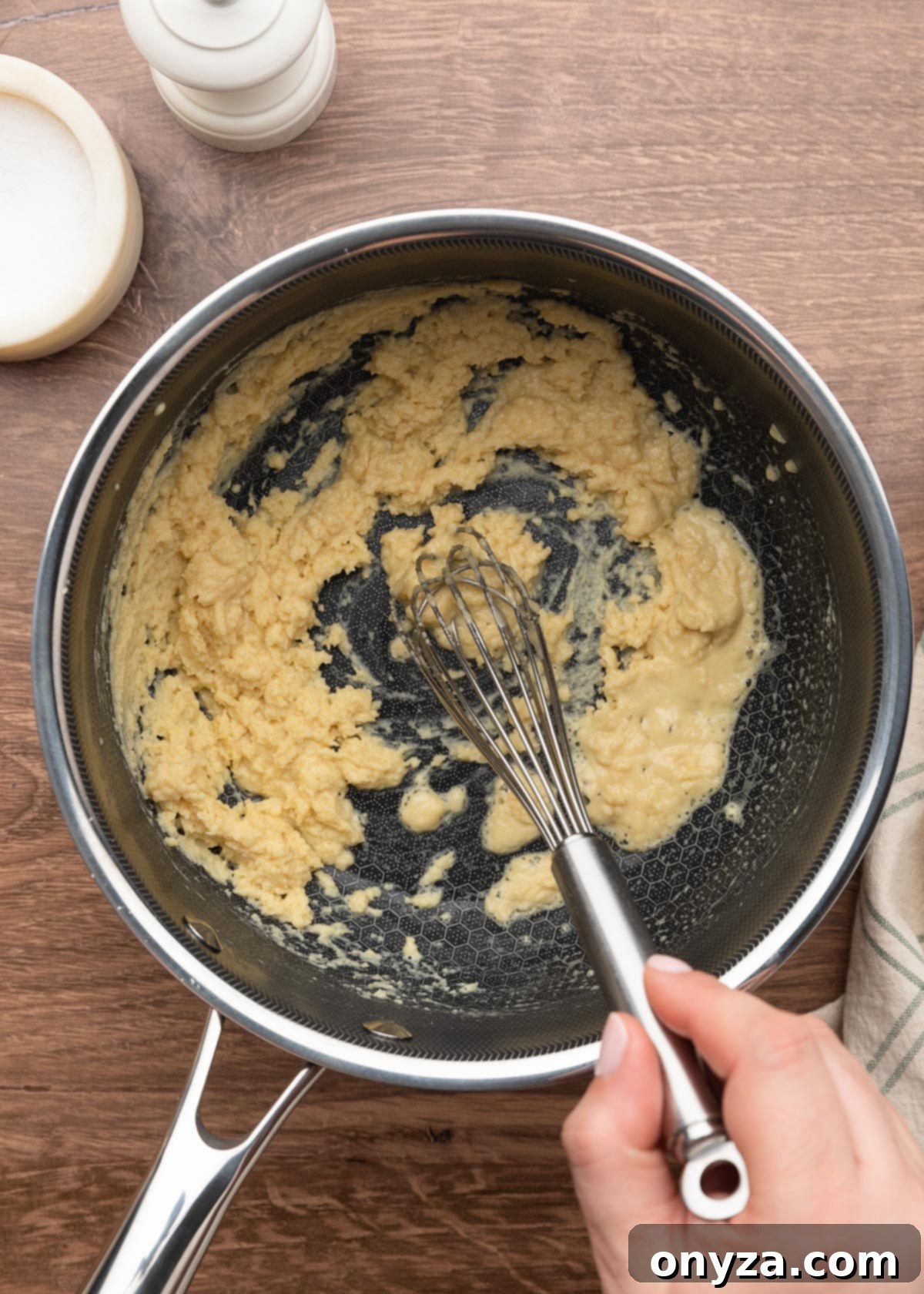
Step 2: Gradually Incorporating Chicken Broth or Stock
Now, remove the pot from the heat. This step is critical for preventing lumps. Gradually whisk in the chicken broth or stock, adding it in small increments, about 1/2 cup at a time.
The roux will absorb the liquid quickly and thicken significantly with the first few additions. To ensure a perfectly smooth, lump-free soup, it’s essential to whisk thoroughly after each addition until the mixture is completely smooth before adding the next 1/2 cup of broth. Patience here will be rewarded with a silky-smooth base.


Tip: Choosing Your Chicken Broth for Optimal Flavor and Sodium Control
The sodium content in commercially available chicken broth or stock can vary dramatically. Some brands contain as much as 800 mg or more of sodium per cup, which can result in an excessively salty homemade condensed soup, especially when used in other recipes.
For the best control over the final saltiness, I strongly recommend using a low- or reduced-sodium variety, or ideally, homemade chicken broth if you have it. This allows you to adjust the salt to your personal preference later in the process, ensuring a perfectly seasoned soup or dish. For this recipe, I found Kirkland Signature Organic Chicken Stock, with 440 mg of sodium per cup, offers a good balance for most dishes. If you prefer an even lower-sodium option, Pacific Foods Organic Free Range Chicken Broth, with just 50 mg of sodium per cup, is an excellent choice.
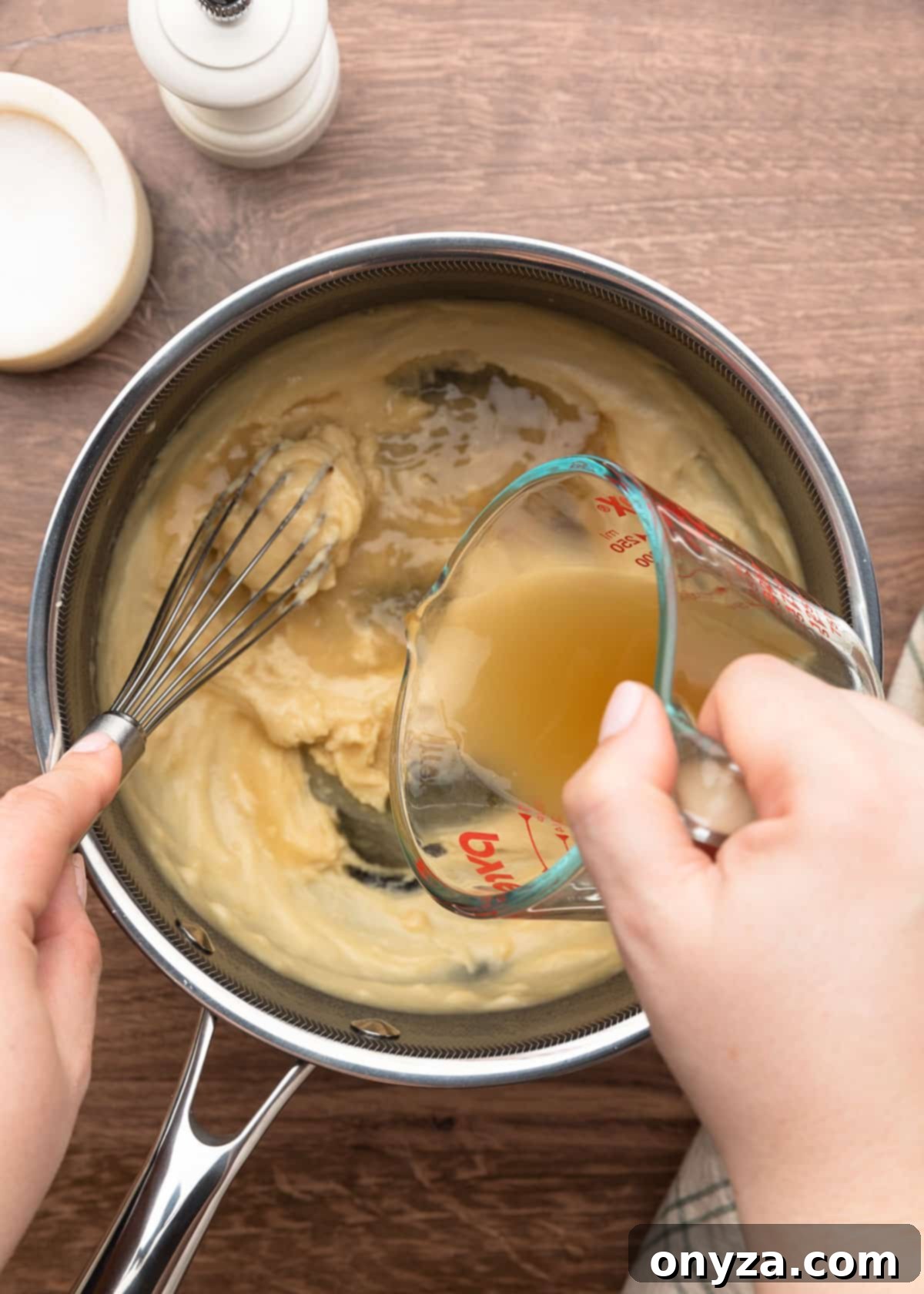
Step 3: Enhancing Flavor with Milk and Seasonings
Once all the chicken stock has been thoroughly incorporated into the roux, it’s time to add the creamy element and a medley of aromatic spices that define the classic cream of chicken flavor. Whisk in the following ingredients:
- Milk: For optimal creaminess and richness, whole milk is recommended. However, 2% milk will also work well, resulting in a slightly thinner, but still delicious, soup.
- Roasted Chicken Base: This ingredient is a secret weapon for intensifying the chicken flavor. A concentrated paste like Better than Bouillon Reduced Sodium roasted chicken base provides a deep, savory, umami note that canned soups often lack.
- Poultry Seasoning: A salt-free poultry seasoning blend adds a classic aromatic profile. Bell’s Seasoning, a harmonious blend of ground rosemary, oregano, sage, ginger, thyme, and pepper, is a personal favorite for its traditional taste.
- Ground Spices: Onion powder, garlic powder, celery salt, and a subtle pinch of sweet paprika contribute savory depth and a balanced aroma. These dry spices are crucial for building complex flavor without adding chunky bits. When measuring, I recommend using “lightly rounded” spoonfuls for a bolder flavor that’s still balanced.
- Kosher Salt and Freshly Ground Black Pepper: These are essential for seasoning. Remember to adjust the salt to taste, especially depending on the sodium content of the broth you’ve used. It’s always easier to add more salt than to fix an overly salty dish.
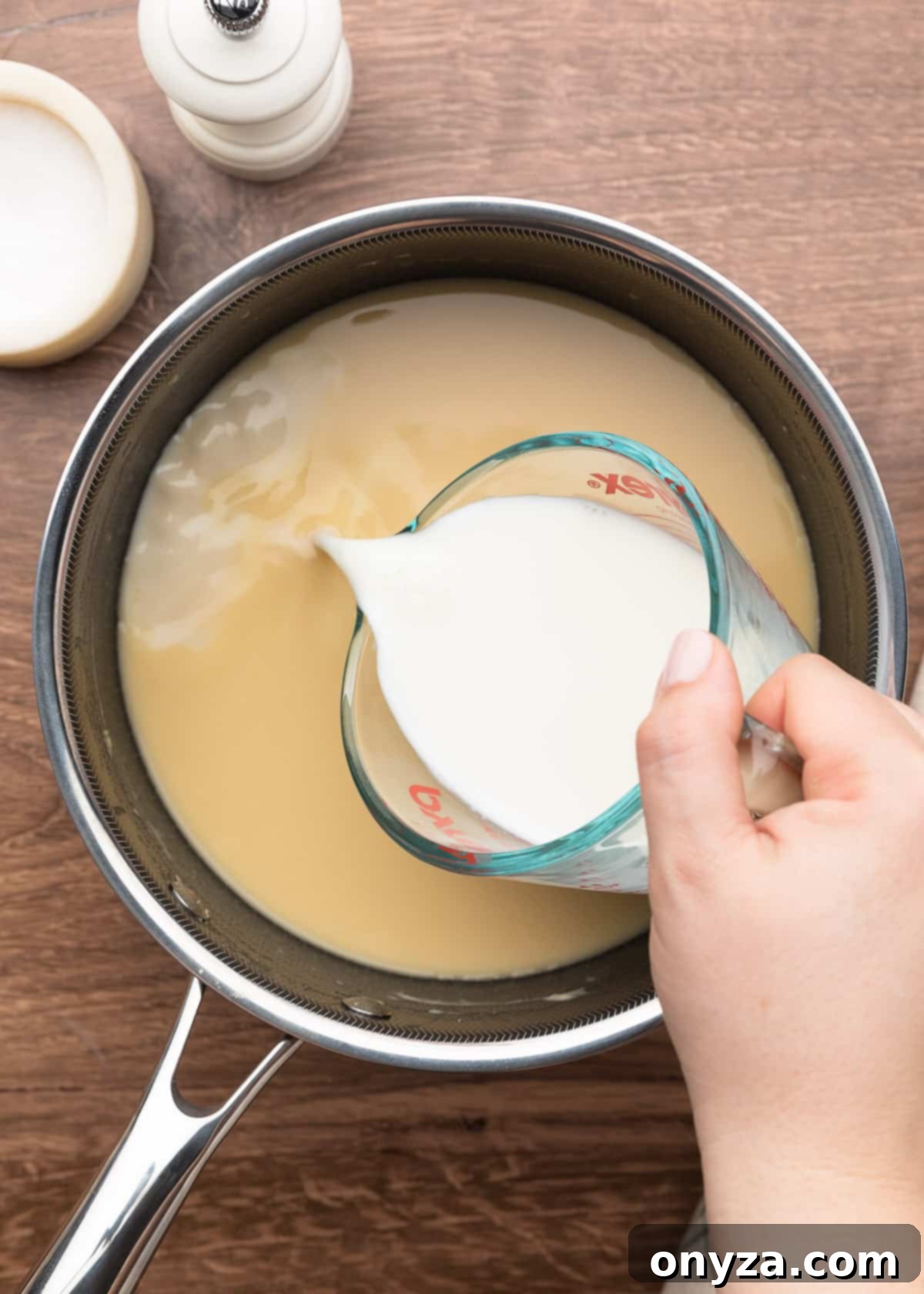
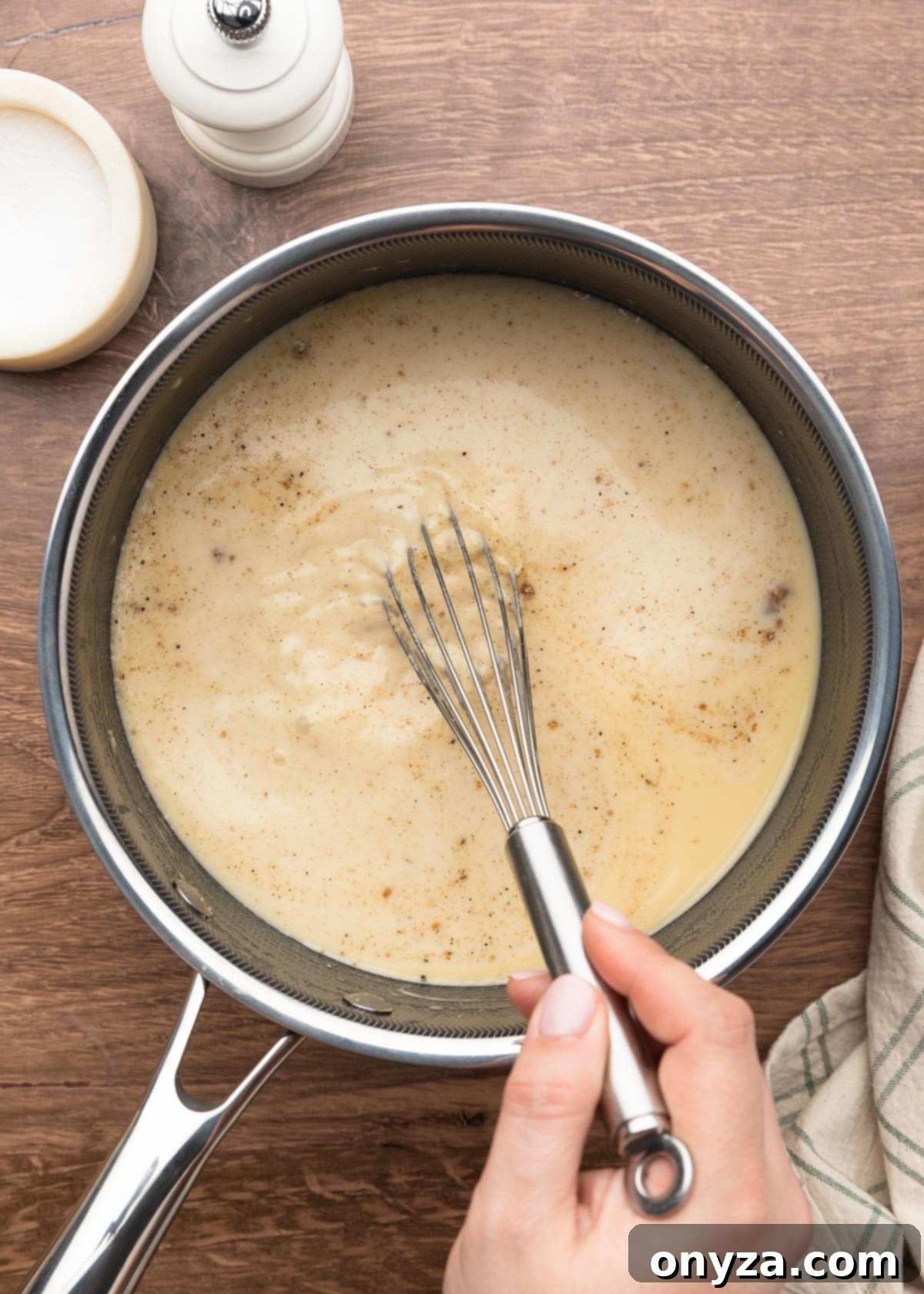
Step 4: Simmering to Perfection and Cooling
Return the pot containing your soup mixture to medium heat on the stove. Bring it to a gentle boil, making sure to whisk frequently to prevent scorching and ensure even thickening. Once the soup begins to bubble, continue cooking and whisking for an additional 3-4 minutes.
As the soup heats and cooks, you’ll observe it gradually thickening. A key indicator that it’s reaching the right consistency is how the bubbles on the surface behave: they will begin to rise and pop more slowly, and you might even hear a difference in their sound as the liquid becomes denser. This signifies that your condensed soup is developing the desired rich, thick texture.
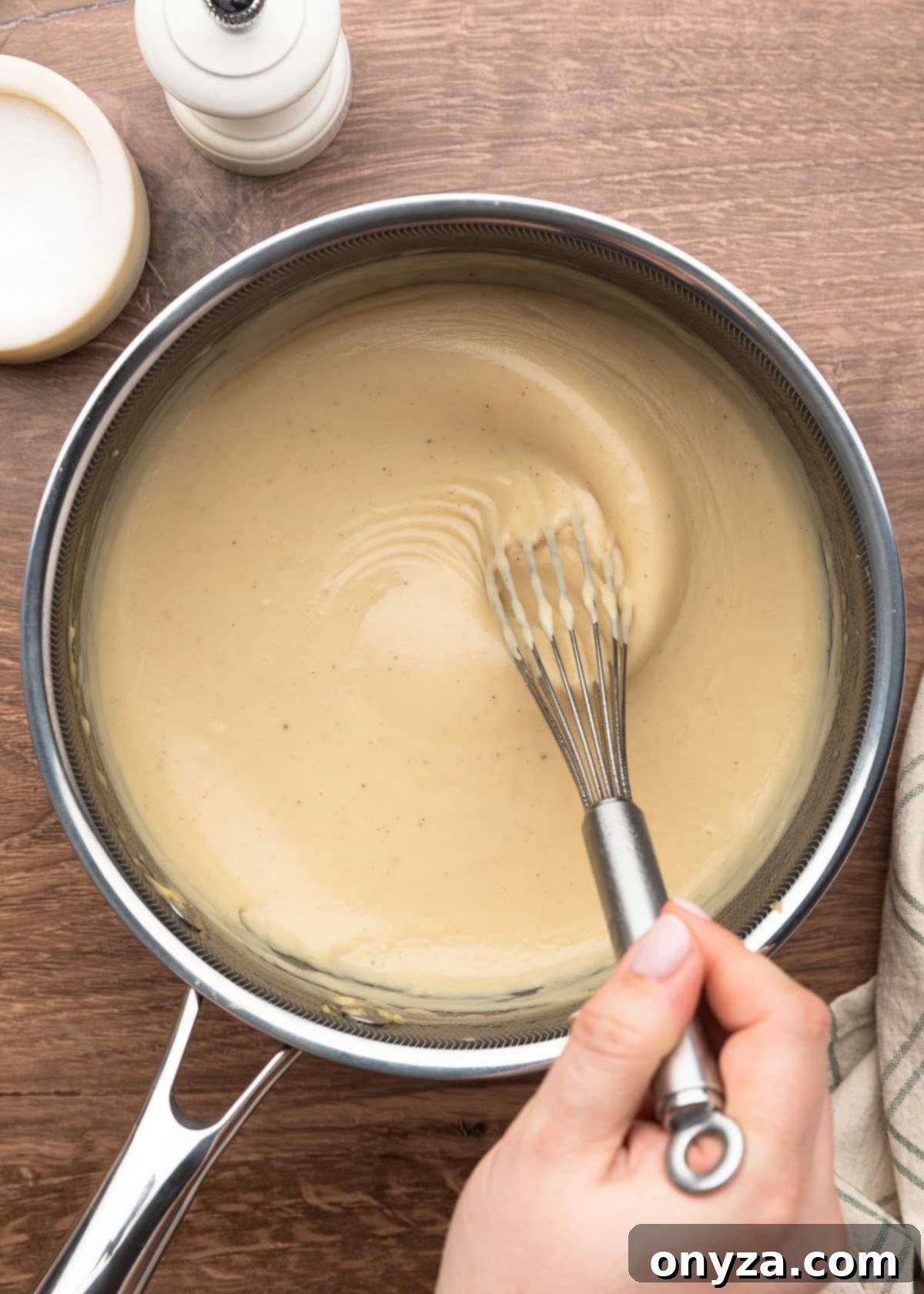
Once the desired thickness is achieved, remove the pot from the heat. Taste the soup and adjust the seasoning with additional salt or pepper if needed. If, despite your careful whisking, you find any small lumps, you can pass the soup through a fine-mesh strainer to achieve an ultra-smooth consistency. However, if you followed the gradual liquid addition and thorough whisking technique, this step is often unnecessary.
Transfer the finished soup to a heat-safe container with a lid. To prevent a “skin” from forming on the surface as it cools, a common occurrence with creamy soups, press a piece of plastic wrap directly onto the surface of the soup before covering. Allow the soup to cool to close to room temperature before using it in recipes or storing it. It will continue to thicken significantly as it cools, which is exactly what we want for a condensed soup. For food safety, ensure the soup is refrigerated within 2 hours of preparation.
Creative Variations for Your Homemade Soup
One of the beauties of homemade condensed soup is its adaptability. Experiment with these variations to customize the flavor profile to your liking:
- Herbed Cream of Chicken Soup: While poultry seasoning already provides a lovely herbal base, you can further enhance it by mixing in 1 teaspoon of dried parsley flakes and/or 1/2 teaspoon of dried basil or dill along with the other seasonings.
- Add Diced Chicken: For an even richer chicken flavor and more substance, stir in 1/4 cup of finely diced cooked chicken breast after the condensed soup has finished cooking and thickened. Be mindful that adding cooked chicken will reduce the soup’s refrigerator shelf life to 3-4 days, calculated from the day the chicken was originally cooked.
- Unsalted Option: For those on very strict low-sodium diets, use unsalted broth or stock and omit the kosher salt entirely. Substitute an equal quantity of ground celery seed for the celery salt and use a salt-free bouillon powder (granulated bouillon) instead of chicken base.
- Mushroom Twist: Sauté finely diced mushrooms (like cremini or button) until golden, then stir them into the finished condensed soup for a “Cream of Mushroom Chicken” flavor.

Storing Your Homemade Condensed Cream of Chicken Soup
Proper storage is key to enjoying your homemade condensed cream of chicken soup whenever you need it. Stored in an airtight container, it will keep beautifully in the refrigerator for up to 5 days.
It’s important to note that when chilled, this homemade version will thicken even more than commercially canned condensed soups. This is perfectly normal and a testament to its rich, real ingredients; it will not negatively affect its performance in recipes. Simply give it a good stir before measuring out the desired amount.
While you can freeze the soup in an airtight container for up to 3 months, it’s not my preferred storage method for this particular recipe due to slight textural changes. If you do choose to freeze it, keep these tips in mind:
- Leave about 1/2 inch of headspace at the top of the container to allow for expansion during freezing.
- Thaw the frozen soup overnight in the refrigerator for best results.
- After thawing, the soup may appear slightly thinner or show minor separation and a slightly grainy texture. Don’t worry! Vigorously whisk the soup to re-emulsify it. It will come back together smoothly when reconstituted and heated in a recipe.
For the best, creamiest texture and ease of use, I strongly recommend storing this Condensed Cream of Chicken Soup in the refrigerator rather than freezing it.
Due to its milk and flour content, this soup is not suitable for canning. The home canning process for products with dairy and thickeners requires specific pressure canning methods that are not typically safe for homemade creamy soups. For more information, you can consult reliable sources like Penn State Extension on Foods That Are Not Safe To Can.
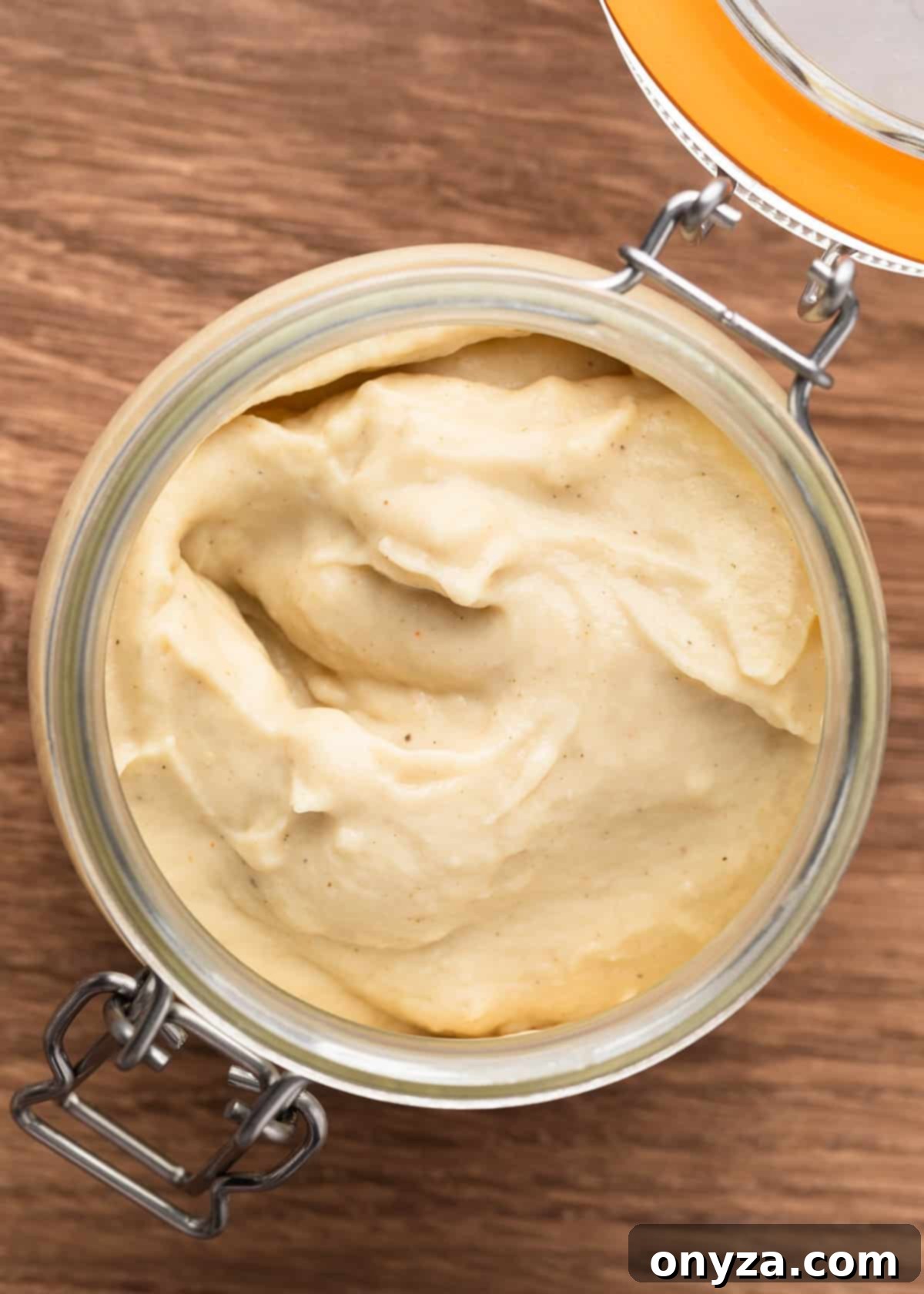
How to Seamlessly Use Homemade Condensed Cream of Chicken Soup
This homemade condensed cream of chicken soup is incredibly versatile and can be used in two primary ways, mirroring its store-bought counterpart:
- As a Quick, Delicious Cream of Chicken Soup: To enjoy this as a standalone soup, simply mix equal volume measurements of the condensed soup and milk in a pot. For instance, if you use 1 cup of condensed soup, add 1 cup of milk. You can also use a mixture of milk and water or broth for a reconstituted soup that is slightly less rich. Gently warm the mixture on the stove over medium heat, whisking until it’s heated through and perfectly smooth. This makes for a comforting, quick meal on its own.
Tip: Elevate your simple cream of chicken soup into a hearty “Chicken Pot Pie” soup! After reconstituting, stir in some diced or shredded cooked chicken breast, a handful of steamed mixed vegetables (peas, carrots, corn), and a sprinkle of fresh chopped thyme. Serve it with a warm biscuit for a truly satisfying and easy take on a classic comfort food.

- In Recipes Calling for Canned Condensed Soup: This recipe yields approximately 2.75 cups of condensed soup, which is a little more than the content of two standard 10.5-ounce cans (each can typically holds about 1-1/4 cups). Use your cooled, homemade condensed soup as a direct 1:1 substitute for canned versions. So, if a recipe calls for one 10.5-ounce can of condensed soup, simply measure out 1-1/4 cups of your homemade creation.
I have personally tested this recipe in numerous family-favorite casseroles that traditionally call for canned condensed soup, and the results have been consistently beautiful and flavorful. While it’s impossible to guarantee perfect results in every single recipe, it has proven to be a reliable and delicious alternative in all the dishes I’ve tried. Some of our absolute favorite applications include a creamy Chicken Broccoli Rice Casserole and a comforting Crockpot Hashbrown Potato Soup. Its rich, savory profile also makes it an excellent base for gravies, creamy pasta sauces, and pot pies, adding a depth of flavor that store-bought versions often lack.
More Delicious Soup Recipes to Explore
If you’ve enjoyed making this versatile condensed soup, you might be interested in exploring other homemade soup creations:
- Split Pea Soup with Ham
- Homemade Cream of Mushroom Soup
- Italian Wedding Soup
- Creamy Turkey Wild Rice Soup
- Rotisserie Chicken Gnocchi Soup
- Creamy Sausage Tortellini Soup
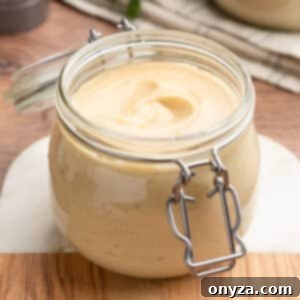
Homemade Condensed Cream of Chicken Soup
Learn how to make homemade Condensed Cream of Chicken Soup with this simple recipe! Perfect for casseroles, soups, and more, it’s rich, flavorful, and easy to customize the sodium content to your preferences.
Cook Time: 15 minutes
Cooling Time: 1 hour
Total Time: 1 hour 25 minutes
Servings: 5.5 servings (1/2 cup condensed soup)
Ingredients
- 4 tablespoons unsalted butter (Kerrygold recommended)
- 9 tablespoons all-purpose flour (1/2 cup plus 1 tablespoon, 70.3 grams total)
- 2 cups chicken broth or stock (low-sodium recommended, see notes below)
- 1 cup milk (whole milk recommended, see notes)
- 1 teaspoon roasted chicken base (Better Than Bouillon Reduced Sodium recommended)
- ½ teaspoon onion powder, lightly rounded (see notes below)
- ¼ teaspoon granulated garlic powder, lightly rounded
- ¼ teaspoon poultry seasoning (Bell’s Seasoning recommended), lightly rounded
- ¼ teaspoon celery salt, lightly rounded
- 1 pinch sweet paprika
- ½ teaspoon Diamond Crystal kosher salt (adjust to taste)
- ¼ teaspoon freshly-ground black pepper
Instructions
- In a medium saucepan, melt 1/4 cup of unsalted butter over medium heat. Once melted, reduce the heat to low and whisk in the flour. Whisk continuously for about 3 minutes to cook out the raw flour taste and avoid browning, keeping the roux light in color. The mixture will start out very thick and clumpy but will loosen slightly into a more paste-like consistency as it cooks.
- Remove the pan from the heat and slowly whisk in 2 cups of chicken broth or stock, 1/2 cup at a time. Whisk to fully combine each addition and smooth out any lumps before adding more liquid.
- Whisk in the milk, chicken base, onion powder, garlic powder, poultry seasoning, celery salt, paprika, salt, and pepper.
- Place the pot back on medium heat and bring the mixture to a boil, whisking frequently. Once it starts to bubble, cook for 3–4 minutes, gently whisking continuously until the soup thickens. You’ll notice that the bubbles that rise to the surface will pop more slowly when the soup is ready.
- Season the soup to taste with additional salt, only if needed. If desired, you can strain the mixture through a mesh sieve to remove any lumps before storing. (You might not need to strain if the stock was whisked in incrementally and whisked thoroughly.)
- Transfer the soup to a heat-proof container and cover with plastic wrap pressed directly onto the surface to prevent a skin from forming. Cool to room temperature before using in a 1:1 ratio for canned condensed soup in your favorite recipes. If you’re making the condensed soup to use later, refrigerate it within 2 hours.
- Store in an airtight container in the refrigerator for up to 5 days. Freezing is possible but not preferred due to a slight change in consistency after thawing. See the “Storing The Soup” section in the article above for more information and instructions.
Notes
Serving Size: The serving size and nutrition estimate have been calculated for the soup in its condensed form, not reconstituted.
Milk: I use whole milk for its rich creaminess, but you can substitute 2% milk (the soup will be slightly thinner). I do not recommend using 1% or skim milk, and non-dairy milk alternatives have not been tested for this recipe.
Ground Spices: When measuring onion powder, garlic powder, poultry seasoning, celery salt, and paprika, I use lightly rounded (not heaping) measuring spoons instead of leveling them. This typically gives the soup just the right amount of seasoning—a little bit more than a leveled measurement but less than the next standard size of measuring spoon. For reference, here are approximate weights for these “lightly rounded” measures (you don’t need to be this exact!):
- Onion Powder: 1.6 grams
- Granulated Garlic Powder: 1.2 grams
- Celery Salt: 1.5 grams
- Bell’s Seasoning: 0.5 grams
- Paprika: 0.2 grams
Chicken Broth/Stock: Sodium levels in store-bought broth/stock can vary significantly, with some containing over 800 mg per cup. Opt for a low- to moderate-sodium or homemade broth/stock to effectively control salt levels, and adjust seasoning as needed. For this recipe, Kirkland Signature Organic Chicken Stock (440 mg sodium per cup) was used, but Pacific Foods Organic Free Range Chicken Broth (50 mg sodium per cup) is also recommended for a much lower-sodium choice.
Nutrition Estimate
Serving: 0.5 cup | Calories: 161kcal | Carbohydrates: 13g | Protein: 5g | Fat: 10g | Saturated Fat: 6g | Polyunsaturated Fat: 1g | Monounsaturated Fat: 3g | Trans Fat: 0.3g | Cholesterol: 27mg | Sodium: 448mg | Potassium: 163mg | Fiber: 0.4g | Sugar: 2g | Vitamin A: 338IU | Vitamin C: 0.1mg | Calcium: 65mg | Iron: 1mg
Nutrition information is automatically calculated, so should only be used as an approximation.
About our recipes
Please note that our recipes have been developed using the US Customary measurement system and have not been tested for high altitude/elevation cooking and baking.
